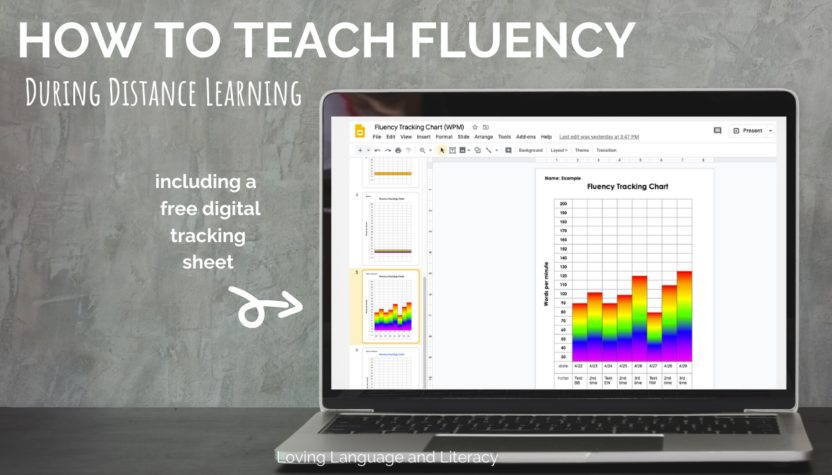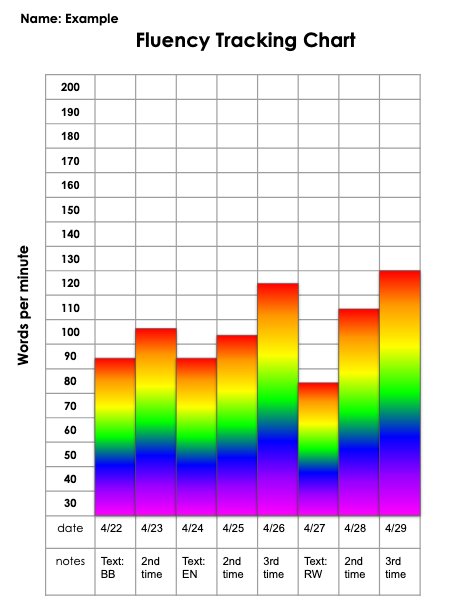Fluency was probably the area of literacy I neglected early on in my career. I started my career in upper elementary and most of my kids were fluent readers (if you only looked at speed). In reality, I had a limited view of what fluency really was and I wasn’t clear on how to teach fluency effectively. I had also missed the vital connection between fluency and comprehension.
Planning fluency lessons in distance learning
1. Pick a fluency focus
Fluency is not just reading fast! Speed is only one aspect of fluency. Fluency also includes accuracy and expression. Expression includes the inflection, pauses, and tone of voice you use when you read. You should pick either accuracy, speed, or expression as a focus for an activity.
With disfluent students who read accurately, I’d recommend starting with a speed focus until students improve then add in activities focused on expression. You will probably choose a different focus for different groups of students in your class.
In 2nd or 3rd grade, for example, your groups may look like this:
| Group | Fluency Focus |
| Striving Readers | Increasing accuracy and sight word recognition; increasing speed |
| On-Level Readers | Increasing speed 2x/week and expression 3x/week |
| Above-Level Readers | Expression focus: intonation, pausing between phrases, using character’s voices |
If you decide to work on speed, check out my free digital WPM fluency tracking sheet.
2. Select appropriate texts for teaching fluency
The most common mistake teachers make with fluency instruction is selecting texts that are too difficult.
This is so important! Listen up: texts for fluency work should always be at a student’s independent reading level. They should be easier than guided reading texts and should feel “easy” to read at a slow pace. Students should be able to read fluency texts with 98-100% accuracy. The most common mistake teachers make with fluency instruction is selecting texts that are too difficult.

Fluency texts should feel “easy” for kids because we are working on automatic recognition, not decoding. Kids should not be sounding out most of the words in a fluency text. Picking texts that are too hard for fluency work will only lead to frustration and low motivation for young readers. Fluency work can be a great confidence booster for striving readers because they should feel successful!
3. Choose a method for teaching fluency: Teacher Led or Parent Led
You have 2 choices for carrying out fluency instruction:
Teacher led: Work on fluency during live phone calls or video lessons. I chose this method because I’m not trying to add more to my families’ plates right now. Consider your own teaching context.
Parent led: Provide texts and step-by-step instructions to parents and have them track progress and share with you.
You can do fluency work live, but it works best when you are meeting with small groups. This is how I’m doing it right now on Zoom. My lower level group is focused on accuracy and increasing speed, and my higher group is working on expression as we read a novel together. You may also want students to record their reading for you to listen to later. Use a recording program that parents can share or something more student-led like Flipgrid.
4. Track progress in fluency growth
Another great motivator for students is helping them see their growth in fluency. If the focus is on speed, they can use a words-per-minute tracker.
I made a Digital Fluency Tracker in Google Slides that you or your students can use to chart fluency growth.
If the focus is on expression, you may want to have students record their reading and listen and reflect on how they are doing with intonation, pausing, and characterization.
If the focus is accuracy, students can read aloud to a parent while the parent keeps a tally of any miscues. They can try to read with better accuracy on each repeated reading
5. Keep fluency instruction fun!
Here are some ideas for making fluency work engaging
- Make it a celebration when they hit their fluency goals! Get excited when they make progress. Find some ‘digital stickers‘ to put on their Digital Fluency Tracker (do a Google image search for something they love and paste it at the top of their fluency tracker–cheaper than scratch and sniff, for sure).
- Use reader’s theater to practice expression and intonation. You could have students record videos of themselves playing different characters (always with parent permission).
- Have students record their voice over a video or slide show. WeVideo is a good kid-friendly video editing program that I’ve used with students as young as 2nd grade. There is a learning curve with it, for sure, but some of my students really enjoy using WeVideo.
- Have kids record a podcast! For an expression focus, have students write and record a “podcast” to share with their classmates. This could be such an engaging, higher-order task to practice writing, research, reading, creativity and fluency!
Don’t neglect fluency work
Fluency is such a crucial part of reading development. It is something that students can work on with a little help and it will build their confidence. All things considered, it is an easier task for parents to help with. Set a timer for 1 min, have your student read, count the number of words, and write it down. We really don’t need to be overwhelming families right now–keep it simple.
Grab my Digital Fluency Tracker as my gift for joining the LLL community! I made it for myself, and I’m using it right now with one of my groups! I hope you like it too.
PS… it is totally editable and you can download and print copies to use when we are back in the classroom too!

Let me know if you have any questions–head on over to my Instagram and slide into my DMs or send an email to: info[at]lovinglanguageandliteracy[dot]com with any questions!


